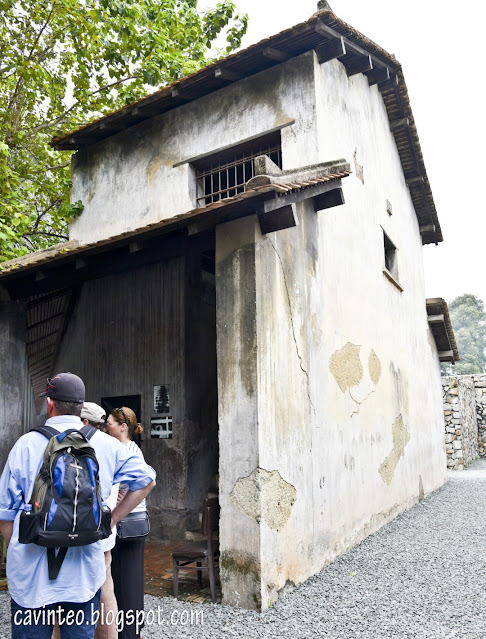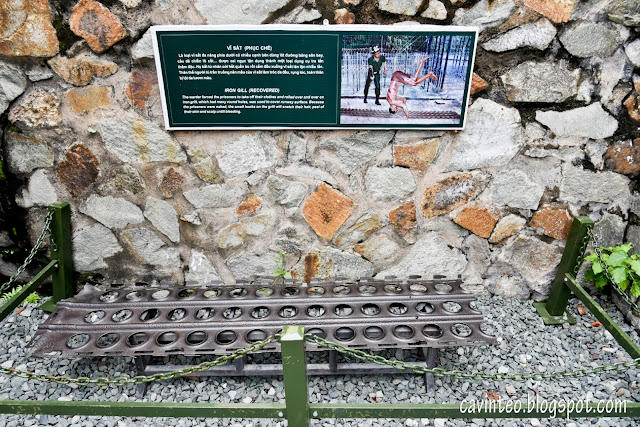Wars are scary, and the imprisonment systems during the wars are not the kind we would have expected in Singapore. In the past, conditions were a lot worse although nothing quite prepared me for the system put in place during the Vietnam War.
The above was the entrance of a side exhibit of War Remnants Museum in Ho Chi Minh City (HCMC) and since I had already paid the entrance fees for the museum; let's not waste our money.
During the Vietnam War, many prisons were built by the U.S government and the Republic of Vietnam and that included interrogation and concentration camps.
One of the main prisons was Chi Hoa in HCMC; completed in 1953 and designed by a Japanese architecture in the shape of an octagon, it served as a transitional camp during the war for political prisoners, prisoners of war and juvenile prisoners. From Google Map, it appeared to be still in use as a prison.
Tortures were common; unimaginable in the brains of those who have never been through war. Imagine having your good teeth removed, malnutrition, sleep deprivation etc. It's all the more disturbing and of more concern with the current Ukraine War. Do you think things have changed? It never does, I feel.
There were a lot more info on the imprisonment system but nothing beats seeing it for yourself; plus, too much information for me to share in this posting too. Ending the exhibit with a projection room that would bring us to the next but attached exhibit, the tiger caves.
It has nothing to do with tigers! In fact, this was a replica on the prisons during the war, including ways of torture to break the body and mind of the prisoners.
Cobblestone walls, gravel flooring.
Bare and cold.
The guillotine; with a blade that weighed 50 kilograms, this was "transported to all the provinces in South Vietnam to decapitate" those who went against the southern Vietnam government (also known as the Republic of Vietnam". Last execution was in 1960.
Cages with barbed wires; intent wasn't to catch small animals. Prisoners would be kept within; and they could only stoop or lie down. The smallest was 1.8m x 0.75m x 0.4m and can house 2-3 persons; that's literally just enough for one person!
A two-storey building.
Using painting, it showed a section of what a typical tiger cage would look like. On its own, there wasn't anything surprising with cells along the 'corridor'.
You can also peek in where mannequins would portray the life of a prisoner; in prison garb, disheveled, with traces of torture (bald patches on the head, injured eye etc).
In this case, the 'prisoner' was shackled which means she would have to urinate and defecate on the stone bed, unless she can ask for permission to be unshackled and release on the floor. The smell would likely stink the room and leave no trace of dignity for an otherwise healthy adult.
Stairs leading to level two.
Notice before proceeding up. Narrow and steep, please keep in line and do not push! I wonder if visitors have fallen from this flight of stairs before; wouldn't be surprised if there are.
'View' on top - now you know the reason why these were called tiger cages. Guards would stand on the second level, with clear view on the activities within the cages as they patrol up and down the passage.
It was mentioned that tiger cages were special cells for stubborn political prisoners and the jailers would torture by injuring them with sharp sticks. "Valid" excuses to commence torture included "talking, laughing, coughing" or even slapping mosquitoes that were sucking your bloood.
Down on ground level again and there's another cell on the other side of the structure. This time, the mannequin was a man with injuries on his head and leg.
Words on the walls; how did they write when their legs were shackled? During non-winter seasons, there would be about 5-14 prisoners and I guess it would be a nightmare to shackle them in such a small space. They would be shacked during winter when there were only about 1-2 prisoners. Actually, I am more curious about the two containers at the back.
Iron Grill - another torture equipment where prisoners would take off their clothes and roll on it. Given the hooks, skin would be easily torn. It's amazing how creative humans can be when it comes to showing their sadism and powers against the vulnerable.
I thought this would be just an open-air enclosure for prisoners to take a breather. I am just too naïve obviously as such humane treatment might be applicable in peace, but definitely not during war.
Known as sunbathing room, prisoners would strip naked and exposed to the scorching heat during the day. In Côn Đảo Prison, which has been converted into a museum, there are 60 of such chambers that have no ceiling. Just wondering, if have strength, can climb over the wall?
=====
Within War Remnants Museum,
Ho Chi Minh City, Vietnam
























%20-%20Pearl%20of%20the%20Far%20East%20@%20Vietnam%20.JPG)
No comments:
Post a Comment